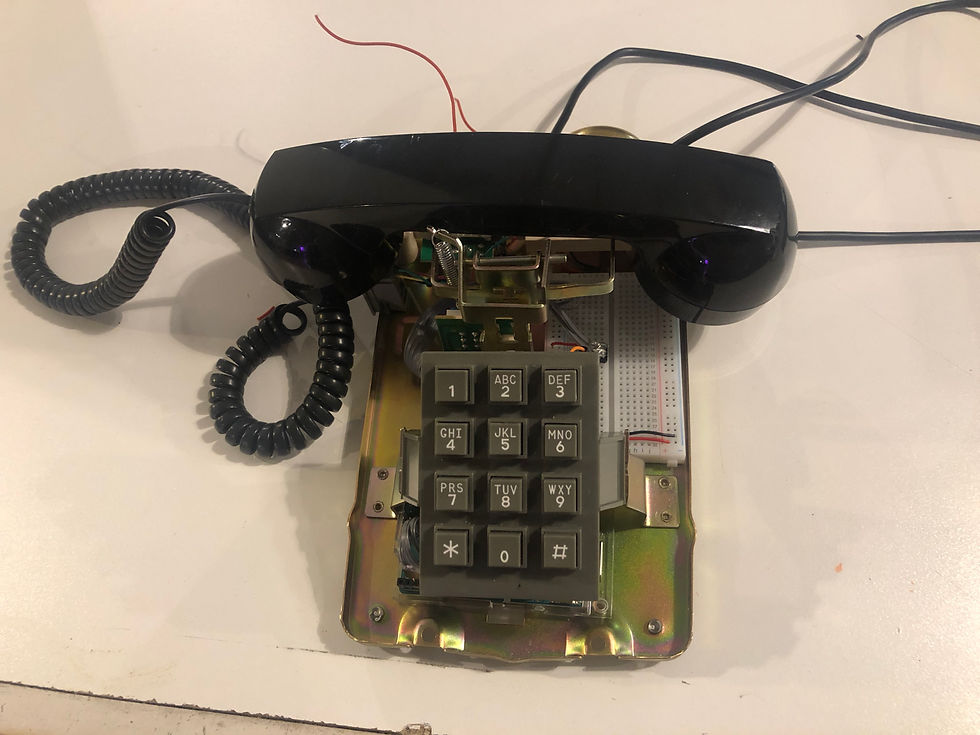PComp MIDTERM: Steampunk Gauntlet
- Gabriella Garcia

- Oct 30, 2018
- 4 min read
Updated: Oct 30, 2018
I'm not feeling nearly as lost as I did a couple weeks ago, but I'm still feeling a certain type of way going into and coming out of midterms. When first considering the assignment, I was thinking of ways I could use ways to finally tie interactivity and what I've learned so far in an interesting way.. I became a sort of "sensor hoarder" and found an ultrasonic range detector on the scrap shelf (I personally refuse [heh] to call it junk) and was inspired to highlight where the technology idea came from by making a bat with servo-controlled wings that would flap when someone walked by. It was something in my head that was both interactive and also read on a deeper level by acting as an IRL bat does.. detecting object by sonic pulse.
Moving from independent learning toward collaboration
We had some basic ideation talk, and landed on creating some computerized elements for a costume I had to make for my part in a wedding. The costume was naval steampunk inspired, and we thought that it would give us opportunity to make use of the visibility of components in the aesthetic and have fun with the fact that we could actually show the moving parts. I'm posting a fabrication gallery at the end of this entry :)
I really wanted to use the opportunity to lock down my knowledge of serial communication, as I hadn't quite gotten there.. I finished the potentiometer lab two weeks back, and was pleased, but for some reason couldn't quite grok the mechanism and got intimidated when thinking of how to use the ADXL345 accelerometer in the same lab since it didn't have the same straightforward hookup as the ADXL335 (see lat blog post). As it turned out, I was actually way closer to achieving that than I thought.. I visited Regina for help after figuring out how to reconstitute the code I found for my accelerometer to only read on the X axis as such:
As it so happens, I was thinking too much. Regina basically explained that my only missing element was having the "readString" element in the p5 side of things after opening the serial port. With Yeseul's help I changed the serial.write elements to numbers so I could more easily have them read by p5, in order to work with them more. I started playing with how to trigger sound based on the read by Frankensteining the serial input lab, as such:
I also wanted to expand beyond the voltage constraints we had been learning thus far... I chose working with a DC motor (motorized fan that I peeled out of a battery-powered fan I had purchased for camping) I could start learning about using transistors and semiconductors. I followed along Adafruit's DC Motor Arduino tutorial, but was having trouble figuring out how to get the motor to keep running rather than pulse. I tapped Ashley for help as she had successfully implemented a DC-motor fan in an earlier project, and she helped me understand where I was going wrong in not altering the loop so the serial input wasn't being "drawn over" immediately. I then translated it to an analog input control instead of serial input control, but I still couldn't quite get the motor to run consistently. I handed off my drafted codes and circuits to my partner, who took them to the next level while I concentrated on the fabrication side of the project.
Feedback and post-project thoughts
I'm not sure where we got off-track in terms of delivering something interactive. I think my partner and I started adhering to what we were each already good at (costume design/fabrication myself, and coding for my partner) and therefore I didn't really get to explore new ideas in interactivity in this medium. I wanted to go further into the coding portion of the midterm, but found myself constrained. I think I'm currently limited by still trying to grasp the tools at hand, which makes it a little harder to step toward applying these tools toward interaction design. I think we could have done better to have more conversations about the application of our knowledge toward interaction design, and it showed in our creating something that didn't totally fulfill the assignment despite displaying both quite intricate code work and fabrication.
I did find the feedback extraordinarily helpful though, in that I do want to make things for performers and I never really had that clearly in my head. Feedback included that when making things for performers, interactivity should be reliably predictable and intentional in whatever computational output is designed, and having that direction spelled out puts some parameters on my ideation that I didn't quite have before. I was asked to perform in a show on November 10th and want to play with some sensor-controlled projections for it, which will be a nice way to start putting the knowledge to use. I use a lot of surprise reveal in my performance persona, so I have a lot of new tools in that kit.
Fabrication Gallery
The costume design portion was really interesting, especially figuring out a way to hide the Arduino and circuits as part of the design. Materials used were foam, acrylic paint, metal rivets, copper piping, fan & motor, work glove, flex sensor, molding clay, LEDs, leather strapping, fabric trim, hot glue, thread, and tape.
Helpful Links & Credits:
Thank you to my partner Adi Dahya, and to Regina Cantu, Yeseul Song & Ashley Lewis for other help.













Comments